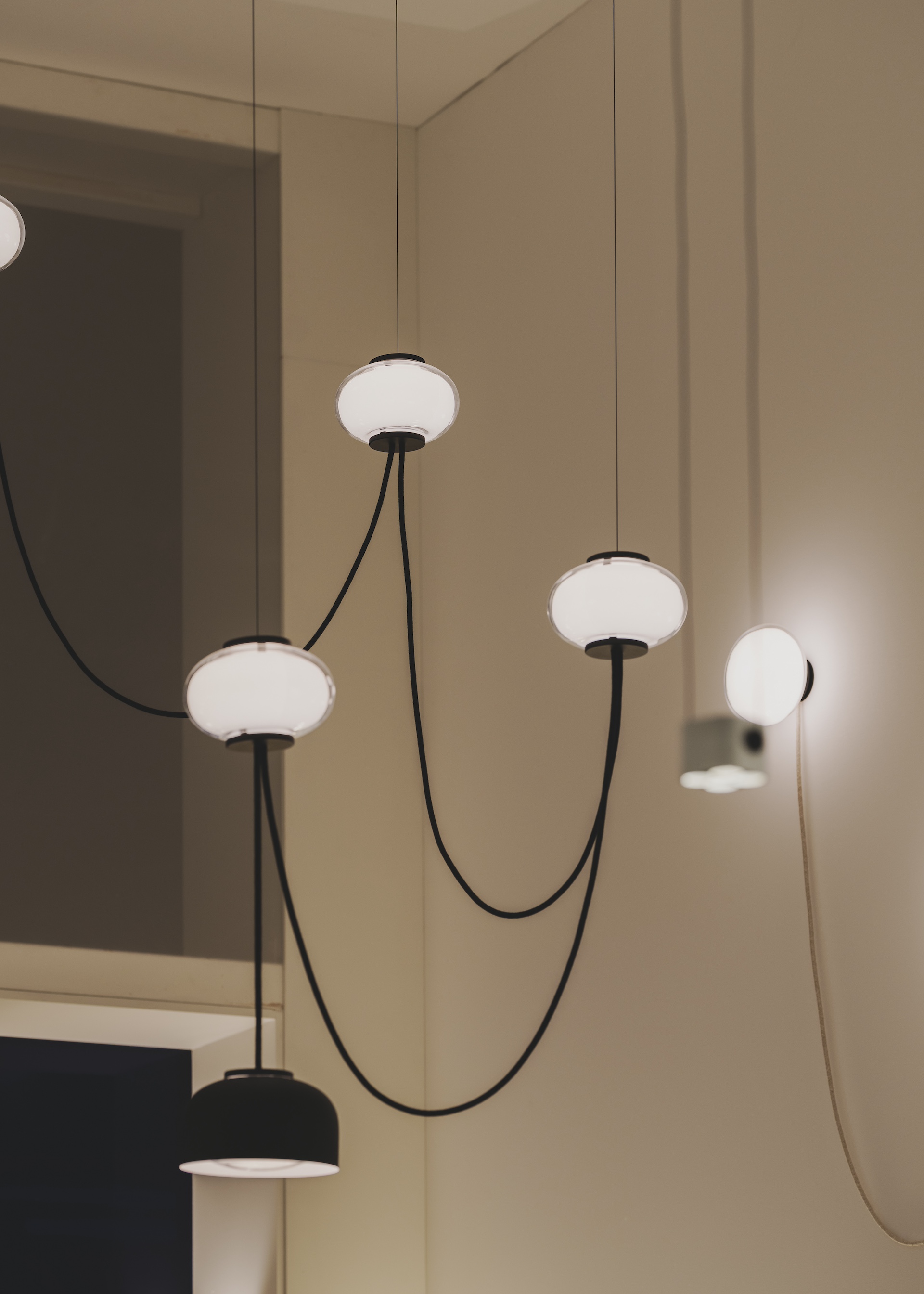In her Milan Diary, editor Kayla Dowling discusses innovation in lighting design and recounts her run-ins with tech-centric brands, products and experiences that articulate their complex nature through analogue interfaces.
A hop away from Milan’s urban rhythm – from where my colleague Chieri Higa has recounted her reports of day one and two of Milan Design Week 2025 – is the equally buzzy biennial Euroluce lighting exhibition at Salone del Mobile. Several halls of precisely lit booths showcase the practical and aesthetic applications of light, but a deeper dive with brands like LedsC4 reveals the technical know-how that informs design innovation in luminescence.
In a stand co-created with Artec Studio under the theme ‘our light identity’, LedsC4’s Euroluce presentation marries technical innovation with sensory-focused design.
In LedsC4 in Hall 4 Stand C21-23 of Rho Fiera, a delicate screen-like textile adorns the stand’s wooden frame, producing a gentle, mediated glow, which continues inside the space co-created by the brand and Artec Studio. Immediately visible is a darkened, central space that showcases Gong, a textile-covered lighting piece, released in a new range of colourways, backlit by a gradually transitioning ombre gradient. Complemented with ambient audio and olfactory elements, the entire booth takes on a sense-friendly quality, a reflection of LedsC4’s holistic design-driven approach. This is also clear through its new design lighting creations like Nahtrang Studio's Hop (pictured above), Jorge Herrera's Twin and Francesc Vilaró's Zup, all of which marry LedsC4’s expertise with versatile, functional and aesthetic designs. The balance between sensory empathy and technical design know-how continues in an outdoor-like area. Here, a screen-covered biophilic installation is ringed by a presentation of practical elements like the outdoor anti-condensation system, Gea Dry®. LedsC4’s more technical elements are shown alongside its design-driven lighting collections.
Google’s Making the Invisible Visible uses sensor technology developed in-house for its consumer devices to create an interactive, playful installation.
Moving from Euroluce back into Milan, I made my way over to Google where – not surprisingly – technology took centre stage. Making the Invisible Visible seeks to do exactly what its name proposes: showcasing the technology that enables ‘good’ design. Co-created by Google’s chief design officer of consumer devices Ivy Ross, her design team and the light and water artist, Lachlan Turczan, the installation invites visitors to play. A dark room filled with mist – which helps to capture the light as an architectural element – is augmented with several downward-facing, ring-shaped lights. Enabled with sensor technology – the same sensors Google has developed and uses in goods like smart thermostats and wearables – visitors can interact with the lights that respond to their movements and create a fluid, dancing beam of light. It was a joy to be in a space that made even the most serious types jump, spin and frolic through the light.
Coffee brand Lavazza proposes an alternative to the wastefulness of capsule coffee machines with its Tabli system in a caffeine-filled installation designed by Juliana Lima Vasconcellos.
After an already long day – and week, that’s just how it goes in Milan, right? –I headed more central and was in desperate need of some caffeine. I dropped into Lavazza’s Fuorisalone installation on Via Senato, A Source of Pleasure, and sipped an espresso made by Tabli, the brand's newest coffee machine. Again, I encountered technology grounding a design experience, working hard behind the scenes to respond to a problem – in this case, the waste associated with at-home coffee drinking. The system comprises a machine and a tab made of 100 per cent coffee grounds, eliminating single-use packaging in an era of throwaway-capsule-coffee-drinking. The espressos were a treat after exploring the installation designed by Brazilian architect and designer Juliana Lima Vasconcellos. Shaped and tinted like the Tabli's coffee tabs, a winding corridor filled with the aroma of coffee led to a room with a waterfall installation and dense plant life. Perched on burlap sack seating inside and in the surrounding piazza, visitors could watch the Tabli machines in action.
Designed by BIG, Roca’s A Beat of Water installation at Università degli Studi di Milano provides visitors with a moment of respite – and an opportunity to reflect – on their water consumption habits.
My last stop of the day – before a much-deserved aperitivo followed by a delicious plate of pasta – was to Interni’s Cre-Action exhibition at the Università degli Studi di Milano. Among presentations from powerhouses like MAD, Piero Lissoni, Zaha Hadid Architects and others was a Bjarke Ingels Group-designed installation for Roca: A Beat of Water. I had the chance to sit down with Bjarke Ingels himself (stay tuned for an interview on Frameweb) for a quick discussion on the collaboration and was immediately struck by a recurring theme. Designed as a ‘call to awareness’ of our water consumption habits, the installation exposes the infrastructure of water that usually remains unseen. Water falls from consecutive metal pipes, arranged in an undulating structure, and is recycled through the system. A planted garden surrounds benches and stools, offering visitors a moment of respite – and reflection on their own relationship with water. Though low-tech in its interface, the installation is a spatial articulation of Roca Connect, a technology that manages water consumption data and enables water conservation.
As conversations around AI and generative technology seemed dominant in recent editions of Milan Design Week, it was refreshing to feel the presence of technology not through the overwhelming presence of screens but through analogue media. Exhibitors presented the opportunity for meaningful gathering and engagement with the content and ideas proposed.


 Cover and above: Courtesy of LedsC4
Cover and above: Courtesy of LedsC4
 Photos: Courtesy of Google
Photos: Courtesy of Google
 Photos: Andrea Guermani
Photos: Andrea Guermani
 Photos: Courtesy of Roca
Photos: Courtesy of Roca